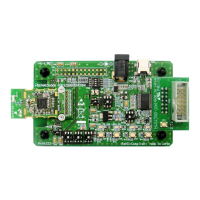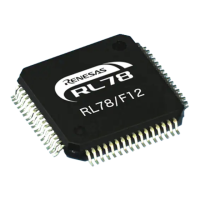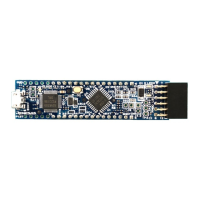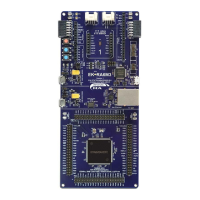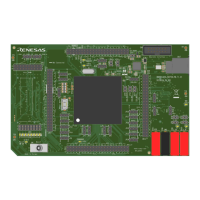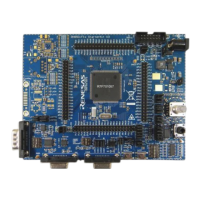RL78/G13 CHAPTER 12 SERIAL ARRAY UNIT
R01UH0146EJ0100 Rev.1.00 662
Sep 22, 2011
Figure 12-95. Flowchart of SNOOZE Mode Operation (Abnormal Operation <2>)
Setting start
Writing 1 to the STmn bit
→ SEmn = 0
Reading receive data to
RxDq (=SDRm1[7:0])
SMRmn, SCRm1: Setting communication
SDRm1
15:9
: Settin
transfer rate
es
Entered the STOP mode
o
raming error or parity error
generated?
es
Does TSFmn = 0 on all
channels?
o
<1>
Channel 0 is specified for UART transmission.
Channel 1 is specified for UART reception.
Be sure to clear the EOCm1 bit of the SCRm1 register to 0.
Setting the SSCm register
→ SWCm = 1, SSECm = 1
<2>
SNOOZE mode setting
Writing 1 to the SSm1 bit
→ SEm1 = 1
<3>
Communication wait status
CLK
supplied to the SAU is stopped.
es
o
Was an RxDq edge
detected?
<4>
<5>
Entered the SNOOZE mode
The clock is supplied and UART reception is started.
<6>
<8>
<7>
Writing 1 to the STm1 bit
→ SEm1 = 0
The mode switches from SNOOZE to normal operation.
Transfer end interrupt (INTSRq)
generated?
es
o
<9>
Clearing 0 to the SWCm bit
Normal processing
Normal operation of UARTq
Clock request signal is set to low-level
The operation of channels 0 and 1 of unit m stop.
The operation of all channels is also stopped to
switch to the STOP mode.)
The clock request signal is set to the high level, and f
CLK
(the high-speed on-chip oscillator clock) is requested for
the clock generator. After the oscillation-accuracy
stabilization time passes, supplying a clock to SAU starts.
SIRm1 = 00H
Clear the all error flags
If an error occurs, because the CPU switches to the STOP
status again, the error flag is not set.
Caution When using the SNOOZE mode while SSECm is set to 1, no overrun errors occur. Therefore,
when using the SNOOZE mode, read bits 7 to 0 (RxDq) of the SDRm1 register before switching to
the STOP mode.
Remarks 1. <1> to <9> in the figure correspond to <1> to <9> in Figure 12-94. Timing Chart of SNOOZE Mode
Operation (Abnormal Operation <2>).
2. 24 to 64-pin products: m = 0; q = 0
80, 100, 128-pin products: m = 0, 1; q = 0, 2
<R>

